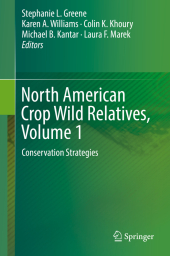 Neuerscheinungen 2019Stand: 2020-02-01 |
Schnellsuche
ISBN/Stichwort/Autor
|
Herderstraße 10
10625 Berlin
Tel.: 030 315 714 16
Fax 030 315 714 14
info@buchspektrum.de |

Stephanie L. Greene, Michael B. Kantar, Colin K. Khoury, Laura F. Marek, Karen A. Williams
(Beteiligte)
North American Crop Wild Relatives, Volume 1
Conservation Strategies
Herausgegeben von Greene, Stephanie L.; Williams, Karen A.; Khoury, Colin K.; Kantar, Michael B.; Marek, Laura F.
1st ed. 2018. 2019. xxv, 346 S. 9 SW-Abb., 39 Farbabb. 235 mm
Verlag/Jahr: SPRINGER, BERLIN; SPRINGER INTERNATIONAL PUBLISHING 2019
ISBN: 3-319-95100-9 (3319951009)
Neue ISBN: 978-3-319-95100-3 (9783319951003)
Preis und Lieferzeit: Bitte klicken
The plant species that humans rely upon have an extended family of wild counterparts that are an important source of genetic diversity used to breed productive crops. These wild and weedy cousins are valuable as a resource for adapting our food, forage, industrial and other crops to climate change. Many wild plant species are also directly used, especially for revegetation, and as medicinal and ornamental plants. North America is rich in these wild plant genetic resources. This book is a valuable reference that describes the important crop wild relatives and wild utilized species found in Canada, the United States and Mexico. The book highlights efforts taken by these countries to conserve and use wild resources and provides essential information on best practices for collecting and conserving them. Numerous maps using up-to-date information and methods illustrate the distribution of important species, and supplement detailed description on the potential value these resources have to agriculture, as well as their conservation statuses and needs. There is broad recognition of the urgent need to conserve plant diversity; however, a small fraction of wild species is distinguished by their potential to support agricultural production. Many of these species are common, even weedy, and are easily overshadowed by rare or endangered plants. Nevertheless, because of their genetic proximity to agriculturally important crops or direct use, they deserve to be recognized, celebrated, conserved, and made available to support food and agricultural security. This comprehensive two-volume reference will be valuable for students and scientists interested in economic botany, and for practitioners at all levels tasked with conserving plant biodiversity.
The chapters ´Public Education and Outreach Opportunities for Crop Wild Relatives in North America´ and ´Genetic Resources of Crop Wild Relatives - A Canadian Perspective´ are open access under a CC BY 4.0 license via link.springer.com.
Securing economically important wild plant species in North America.- Sampling wild species to conserve genetic diversity.- Practicalities of collecting.- Challenges of storing seed of wild species.- Seed production in wild species.- In situ strategies to conserve genetic resources.- Canada.- USA.- Mexico.- Indigenous.- Forging partnerships.- Maize.- Beans.- Grain and cereal crops.- Leafy or stem vegetables.- Root, bulb or tuberous vegetables.- Fruit bearing vegetables.- Temperate small fruits.- Grape.- Temperate tree fruits.- Nut.- Tropical tree fruits.- Sunflower.- Industrial crops.- Forage and turf.- Revegetation species.- Herbaceous ornamentals.- Woody ornamentals.- Aromatics.- Medicinal.


